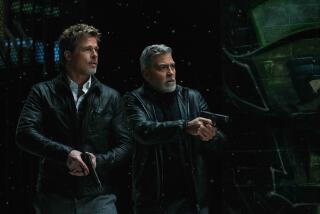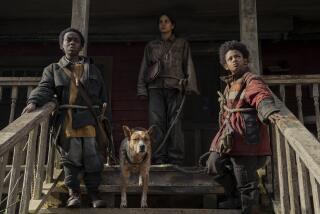COMMENTARY : Out of the Past, Into the Present : Movies: In ‘The Grifters,’ Stephen Frears makes the <i> film noir </i> function as both a fierce piece of nostalgia and, with its harrowing emotions, as a work of startling immediacy.
If you’ve ever seen a movie from the ‘40s or the early ‘50s seething with trapped, doomed suckers, madcap psychos and black-widow vamps, then you’ve seen a film noir . A vintage noir, like “Double Indemnity” or “The Big Heat,” is much more than a psychological thriller; it’s an evocation of dread done up in shadow and rain-slicked streets and no-exit alleys.
“The Grifters,” now at selected theaters after a week’s Oscar-qualifying run last month, looks like a vintage moody-blues film noir from the ‘40s. But look again. Set in Los Angeles in an indeterminate present, it’s a new-style noir . A “grifter” is defined as a con artist, and “The Grifters” is itself a kind of con. It’s a film with all the classic accouterments of the genre that nevertheless seems ambiguously, inevitably modern.
The 1963 Jim Thompson novel on which screenwriter Donald Westlake based his adaptation also quivered with the vibes of an earlier era; director Stephen Frears doesn’t so much update the novel as make it more mysterious. His movie is about how the past--the lurid, pulpy past of crime novels and B movies, with its grungy romanticism--is still everywhere around us. The filmmakers have succeeded in making the film noir function as both a fierce piece of nostalgia and a work of startling, present-tense immediacy. How do they sustain this double vision?
The old-fashioned half of the vision is easy to spot. Frears, in collaboration with cinematographer Oliver Stapleton and art director Leslie McDonald, selects only those present-day Southland locations that seem haunted by the past. The universe of “The Grifters” is a swatch of seedy hotel rooms and diners and bars. The pallid people who drift in and out of the film seem camouflaged by sunlight. Only darkness brings out their true colors, and the colors are all muted.
These creatures of the night are species of vampire, but their bloodsucking takes the form of the grift. And whether they play for high stakes or low, whether they practice the short con or the long, the shine only comes into their eyes when they’re separating someone from his money.
The film’s chief grifters are an unlovely, damned trio: John Cusack’s Roy, a short con artist with sneaky, melting eyes; his mother Lilly (Anjelica Huston), who was 14 when Roy was born and who moves around the country placing racetrack bets for a Baltimore mob chief (Pat Hingle), and Annette Bening’s Myra, a lethal cutie who slithers into Roy’s life as if she was pulling the sweetest of scams.
The film’s then-and-now sleight-of-hand is cunningly achieved. Frears avoids the usual L.A. landmarks; his locations are marginal, anonymous. The cars that we see are all road-worn American models. I don’t think I spotted a single Japanese car (Lilly drives a big old Caddie). The characters don’t sport trendy clothes; Myra’s body-wrap dresses are strictly ‘40s vamp.
The grifters’ patter seems as in-grown and unchanging as a racetrack tout’s slang. Nobody in this film has a modern, aerobicized look; on the contrary, the supporting players, in particular, seem chosen for their decrepitude. The hotel managers and barflies and thugs look like they’re crumbling before our eyes. A tan would be as out of place in this movie as a flying saucer.
In visual terms, Los Angeles may have the reputation for being a big sprawl but, in true noir style, Frears and Stapleton emphasize the vertical over the horizontal; there’s even a split-screen triptych effect right after the opening credits. Everything in the film seems cramped, boxed-in. Elmer Bernstein’s score, with its hyped, lurid melancholy, is like a melange of pulp scores from the past. A narrator--another noir fixture--introduces the movie. (The narrator’s voice belongs to Martin Scorsese, who co-produced.)
“The Grifters” is just as scrupulous about the big details as the small. The great themes of films noirs seep through the imagery like widening bloodstains. The fatalism, the futureless atmosphere of impending dread, the lure of the illicit are all tremblingly present on the screen. There’s an Oedipal tingle to Roy and Lilly’s relationship that’s basic to the genre. It says that at the root of every human connection is a sexual secret.
It’s worth pointing out that Frears, like so many of the great noir directors from the ‘40s and ‘50s, is not American. He’s a Britisher whose best previous films, “My Beautiful Laundrette” and “Dangerous Liaisons,” luxuriate in a slippery morality. It may be that it takes an outsider’s eye to capture the deep-down essence of American hard-boiled romanticism. Unencumbered by the pieties of American life, the foreign-born director can head straight for the impious underside. His off-kilter, stranger-in-a-strange-land view fits right into a genre that, by definition, is off-kilter too.
But what of the ways in which “The Grifters” represents something modern? Film noir flourished in the late ‘40s and ‘50s largely because, in an era of burgeoning, self-interested conservatism, it acknowledged the audience’s unarticulated cynicism and hopelessness. Film noir gave the lie to the official homilies of the postwar popular culture--the home-and-hearth values, the belief that hard work would always be rewarded.
We’ve just passed through a conservative, feel-good era of our own--a period in which the tone of much of popular culture has been determinedly frivolous and sunny and comforting. It’s an era where such movies as “Field of Dreams” and “Pretty Woman” and “Ghost,” with their sugar-coated reassurances, thrived. Since few current movies rake the depths, even the pulp depths, “The Grifters” comes across as more than just a smashing thriller. It comes across as a retort to the sunniness. Its darkness is emblematic.
The people who made “The Grifters” recognize that they’ve hooked into something larger than just another crime story. They don’t, thankfully, trick the movie up with a lot of fancy-pants, deadbeat existentialism, like that other recent Jim Thompson-derived movie “After Dark, My Sweet.” “The Grifters” delivers its pulp pleasures right on schedule--it’s great fun--but it also has a harrowing emotional content that seems specifically modern.
Characters in films noirs are always blended into the shadows. In “The Grifters,” they emerge from the murk, and their features, their souls are almost obscenely explicit. Lilly may have a lissome moll’s figure and a platinum blonde coif, but she’s a ravaged, fully dimensional character. How many fully dimensional characters have there ever been in a film noir ? Not many. Her final cry is torn from some place much deeper than her gut.
And John Cusack’s Roy, who calls himself a “businessman,” may be a more central character for his generation right now than might have been anticipated. He has a forlorn yearning for upward mobility.
In its own sly way, “The Grifters” points up a dirty little secret of modern life. It admits the class divisions in America’s “classless” society, and it expresses the fierce resentment of those who scrounge in its lower echelons. Earlier films noirs also dealt in mayhem and depravity but “The Grifters” carries with it a new attitude. Depravity is portrayed not as some aberration of society but as the essence of society. It’s accepted as the normal run of things, and that acceptance is ghoulishly comic.
More to Read
Only good movies
Get the Indie Focus newsletter, Mark Olsen's weekly guide to the world of cinema.
You may occasionally receive promotional content from the Los Angeles Times.










